July 16, 2011
Fringe : Season 3 : Episode 22 : “The Day We Died”

Peter and Walternate have it out.
In a blitz of warfare and time travel, major characters die (or do they?), universes reconcile (or do they?) with the creation of a joint security area and Fringe events finally come to an end (or do they?). Season four of Fringe begins in September.
This episode is debunked at Polite Dissent and Cordial Deconstruction, and you can read more about it at Fox, IMDb and the A.V. Club.
Random thoughts
In the not-too distant future, ultraviolet radiation can be used to cauterise wounds. I’m not sure what benefits this would have over the more passé infrared radiation (i.e. heat), especially as it could damage DNA around the wound site.
The future Fringe team was able to analyse the carbon levels in the air around the wormhole and deduce that it went 250 million years in the past. We know what the levels of various gases in the air at that time were because we can analyse air trapped in ice sheets that were laid down then. However, I’m not sure if it works both ways – it’s entirely plausible that the air contained a certain amount of carbon (or carbon-containing gases) at several different times in the past.
If atmospheric 90Sr levels were high enough to be detected, wouldn’t the radiation monitoring networks have picked them up already? That’s how the Western world found out about the Chernobyl disaster, which the USSR had kept quiet. Maybe there had been so much upheaval on Earth-1 that the air was already full of radioisotopes.
 Leave a Comment » |
Leave a Comment » |  Fringe, season 3, television | Tagged: e22, episode 22, Fox, Fringe, s03, s3, season 3, television, The Day We Died, TV |
Fringe, season 3, television | Tagged: e22, episode 22, Fox, Fringe, s03, s3, season 3, television, The Day We Died, TV |  Permalink
Permalink
 Posted by John
Posted by John
July 5, 2011
Fringe : Season 3 : Episode 21 : “The Last Sam Weiss”
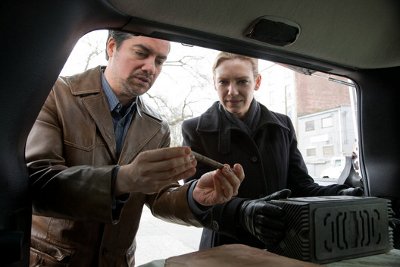
The Last Sam and Olivia locate The Key.
As season three rumbles to its finale, the Fringe/Massive Dynamic teams somehow manage to move The Machine over to Liberty Island so Peter and Olivia can have a crack at switching it off. Expect a thrilling conclusion and/or whopping cliffhanger next week.
This episode is debunked at Polite Dissent and Cordial Deconstruction, and you can read more about it at Fox, IMDb and the A.V. Club.
Random thoughts
As everybody has already pointed out, it is a terrible idea to head to higher ground during a lightning storm. Staying in the car would have been the safest thing to do, especially as the product-placed vehicle in question is probably equipped with Lightning ConductoTM technology.
Would Sam and Olivia really have been able to move the tomb lid that easily? Let’s assume that whatever it is made of has a density of 2400 kg m-3 (which is typical for concrete, and low for most natural stone), and dimensions of 2 m x 1 m x 0.1 m. That gives it a volume of 0.2 m3 and hence a mass of 480 kg (equivalent to a medium-sized polar bear). The Last Sam must have been rolling some pretty heavy bowling balls to build up such strength.
Walter’s “insulation” (rubber boots and gloves) wouldn’t necessarily have protected him from the lightning, but it was largely irrelevant anyway as he was only wearing one glove (he even waves his bare hand around after he gets zapped).
 Leave a Comment » |
Leave a Comment » |  Fringe, season 3, television | Tagged: e21, episode 21, Fox, Fringe, lightning, s03, s3, season 3, television, The Last Sam Weiss, TV |
Fringe, season 3, television | Tagged: e21, episode 21, Fox, Fringe, lightning, s03, s3, season 3, television, The Last Sam Weiss, TV |  Permalink
Permalink
 Posted by John
Posted by John
May 15, 2011
Fringe : Season 3 : Episode 20 : “6:02 AM EST”
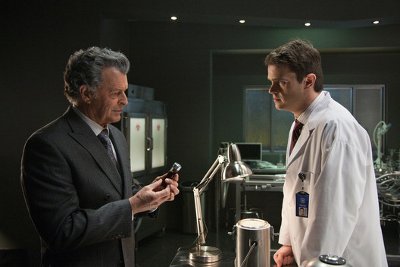
Walternate updates his master plan.
Tensions start to build up for the finale of season three with Walternate activating his Machine and the Fringe team on Earth-1 scrambling to counter-activate theirs. Seeing as Fringe has been renewed for a fourth season, I somehow doubt that Earth-1 will be destroyed.
This episode is debunked at Polite Dissent and Cordial Deconstruction, and you can read more about it at Fox, IMDb and the A.V. Club.
Random thoughts
Faraday cages have been mentioned before, in season two’s White Tulip, as has quantum entanglement (6B, Entrada).
J. Robert Oppenheimer‘s famous quotation, “Now, I am become Death, the destroyer of worlds” is from the Hindu scripture the Bhagavad Gita.
When examining the granite, Walter uses a piece of equipment that looks like an analogue multimeter, but that emits clicks like a Geiger counter. Presumably he is measuring the potential difference between the terminals (as seen by the needle moving), but then what are the clicks for?
 Leave a Comment » |
Leave a Comment » |  Fringe, season 3, television | Tagged: 6:02 AM EST, e20, episode 20, Fox, Fringe, s03, s3, season 3, television, TV |
Fringe, season 3, television | Tagged: 6:02 AM EST, e20, episode 20, Fox, Fringe, s03, s3, season 3, television, TV |  Permalink
Permalink
 Posted by John
Posted by John
April 18, 2011
Fringe : Season 3 : Episode 19 : “Lysergic Acid Diethylamide”

Olivia is on her way back.
The Bell/Olivia storyline is (presumably) resolved with a brief trip into the mind, facilitated by drugs and EEG equipment. We demand to see William Bell return as a rat!
This episode is debunked at Polite Dissent and Cordial Deconstruction, and you can read more about it at Fox, IMDb and the A.V. Club.
Random thoughts

LSD
Lysergic acid diethylamide, better known as LSD, is a notorious psychedelic drug. It is typically taken in doses as low as 20 μg, making the 2000 mg Walter requests (10 million 100,000 doses) a ridiculous proposition. I’m not sure why the Fringe team didn’t strap themselves into the mind-meld equipment and begin the sedative doses before taking the LSD, as presumably Peter could easily have had some kind of freak-out and been unable to participate.
A Bernoulli spiral is a logarithmic spiral often found in nature. The liquorice twists that Broyles was fascinated with are not really related, but who knows what he was seeing.
 2 Comments |
2 Comments |  Fringe, season 3, television | Tagged: e19, episode 19, Fox, Fringe, LSD, Lysergic Acid Diethylamide, s03, s3, season 3, television, TV |
Fringe, season 3, television | Tagged: e19, episode 19, Fox, Fringe, LSD, Lysergic Acid Diethylamide, s03, s3, season 3, television, TV |  Permalink
Permalink
 Posted by John
Posted by John
April 2, 2011
Fringe : Season 3 : Episode 18 : “Bloodline”

Walternate fills the Fringe-2 team in on some state secrets.
In finest soap opera tradition, Olivia-2 will have her baby before the season finishes irrespective of how much time a pregnancy normally takes. They accelerated it with SCIENCE!
This episode is debunked at Polite Dissent and Cordial Deconstruction, and you can read more about it at Fox, IMDb and the A.V. Club.
Random thoughts
Not a lot to talk about this week, from a science perspective at least. Is it safe to use a Taser on a pregnant woman? I assume that Walternate would want to take every possible precaution to prevent damage to his grandson. Also, Olivia-2’s baby managed to grow to full term with no apparent input of mass (a stumble we’ve seen a few times before on Fringe).
 Leave a Comment » |
Leave a Comment » |  Fringe, season 3, television | Tagged: e18, episode 18, Fox, Fringe, s03, s3, television, TV |
Fringe, season 3, television | Tagged: e18, episode 18, Fox, Fringe, s03, s3, television, TV |  Permalink
Permalink
 Posted by John
Posted by John
March 21, 2011
Fringe : Season 3 : Episode 17 : “Stowaway”
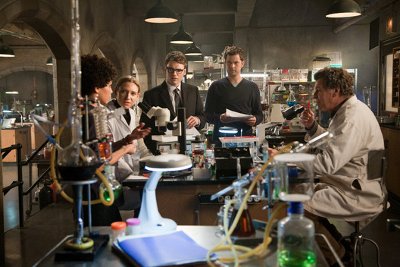
The Fringe team, plus two.
This week in suspension of disbelief: Somebody who can’t die, no matter how much they want to. Instead of becoming a crime-fighting superhero or insulting as many people as possible, our heroine this week opts to just keep on trying. Can William Bell still have the body?
This episode is debunked at Polite Dissent and Cordial Deconstruction, and you can read more about it at Fox, IMDb and the A.V. Club.
Random thoughts
Some musical trivia I actually know, which I’m going to mention even though it has nothing to do with science: The song playing in the lab when Agent Lee walks in is a version of the Dave Brubeck Quartet‘s Take Five, notable for its unusual 5/4 time signature. HT to the CBC.
The series of concepts about why Dana can’t die seems to be quite poorly thought-out. I’ll try and point out where the writers have tripped up, but the whole idea is so firmly rooted in ridiculousness that my explanation may not make any sense either.
OK, so Dana can’t die because the molecules in her body are held together extremely strongly (kind of like Unbreakable, which also features a train). I think that’s what the Fringe team decided. If this were the case, how would any of the myriad biological processes in her body function? I don’t actually think this is the biggest flaw in the story, but it is a stumbling block. Walter (or William) could have explained it away in terms of thermodynamics – chemical reactions could still occur if the changes in energy were favourable.
What I’m less clear on is how Dana survived getting shot in the head twice. We can see a lot of blood from the crime scene photographs, and presumably the bullets went into or through her for the police to know about them. How did she regenerate her brain? Does she have some kind of healing factor as well as a super-dense body (or maybe she just has super-dense bones)? And would her condition actually prevent death if she was really determined to die? Would she be able to survive, say, drowning?
Getting stuck by lightning would not cause a person’s atoms or molecules to suddenly stick together more strongly. I think the explanation was that the lightning bolts somehow ionised or magnetised all the molecules in Dana’s body, which increased the attractive forces between them. Lightning is known to induce magnetism in objects, but molecules aren’t held together by magnetic forces. Molecules and atoms interact via the electromagnetic force (commonly referred to as the electrostatic force in chemistry), which is essentially the attraction and repulsion of positive and negative electric charges. Atoms themselves are held together by the strong force.
I’m actually confusing myself trying to rationalise all of this, so I’m going to stop there. There are multiple points of failure with this story, and they couldn’t even push the explanation onto Universe-2 altering the laws of physics this time. If the real story was about fate – that Dana could be in the right place at the right time to save the train passengers – then I’m sure that the writers could have come up with a simpler and just as entertaining rationale. Perhaps Dana’s body would act unconsciously to save her every time she tried to kill herself? Perhaps she had a super-fast healing factor that repaired her as quickly as she could damage herself?
“One of these things is not like the others,” is a Sesame Street staple. I image that the Earth-2 equivalent would be Alfalfa Avenue.
I’m pretty sure that the “Azrael in Purgatory” story was completely fabricated. Can anyone enlighten (ha!) me?
I know that Fringe is set in the United States of America, but can you really just go out and buy 20 lb. of plastic explosive?
 2 Comments |
2 Comments |  Fringe, season 3, television | Tagged: e17, electromagnetic, electromagnetism, episode 17, force, Fox, Fringe, lightning, magnetic, magnetism, s03, s3, season 3, Stowaway, television, TV |
Fringe, season 3, television | Tagged: e17, electromagnetic, electromagnetism, episode 17, force, Fox, Fringe, lightning, magnetic, magnetism, s03, s3, season 3, Stowaway, television, TV |  Permalink
Permalink
 Posted by John
Posted by John
March 13, 2011
Fringe : Season 3 : Episode 16 : “Os”

The Fringe team investigates flying thieves.
It was only a matter of time before Fringe got round to anti-gravity, and they explained it away quite neatly without having to resort to improbable physics (it was the other universe, innit). Also, William Bell is back and possessed of a new, youthful body. Will Peter ever be able to find Olivia attractive again? Tune in next week!
This episode is debunked at Polite Dissent and Cordial Deconstruction, and you can read more about it at Fox, IMDb and the A.V. Club.
Random thoughts
Walter quotes from the Tragedy of Icarus, but I have no idea which translation/version. I thought that Peter would have made a quip about Icarus falling to Earth instead of floating, but we a rather flat observation from Broyles instead.
Osmium is extremely dense, but it’s not correct to say that it’s the “heaviest” element. Atomic weight typically refers to the weight of the atomic nucleus (i.e. the number of protons and neutrons a nucleus contains), and not the bulk weight of a sample of specific volume. The heaviest naturally-occurring element is plutonium, which is technically unstable but has such a long half-life (about 80 million years) that it is still found in nature. Other than this slight misnomer, all Osmium-related fakts corect for a change.
I know that we are supposed to suspend some disbelief when thinking about the impossibilities that appear on Fringe, but if the blood test on the dead thief didn’t show any osmium (or lutetium) until the effects of the serum wore off, it must have been physically changed into something else. Of course, they might not routinely check for heavy metals but one would think that they’d be as thorough as possible.
Osmium normally melts at about 3300 K, and I’m really confused about why it was necessary to reveal that it now melted at 77 K in reverse. We were already on board with the whole “Universe-2 is messing things up” concept, and this just added a whole new layer of ridiculous.
Lutetium is found on Earth (rather than in meteorites), though it is quite rare, and 176Lu is often used to date meteorites due to its very long half-life, but meteorites would not be considered a good source. Krick appears to be using a UV light and what is probably either a Geiger counter or a magnetometer to find it. These would not be great tools with which to detect a specific element, because so many elements and minerals fluoresce, affect magnetic fields (meteorites usually have a high iron and nickel content) and/or are radioactive. It’s possible that Krick is using a UV light and some kind of spectrometer to look for lutetium’s characteristic absorption lines, but it would be almost impossible to do that in the open air with so many other light sources shining into the detector.
How much Os/Lu would be needed to lift a person? Even assuming that they combine with things in the body (which they must, otherwise all the syringes and containers would be floating off), probably a lot more than the 10 ml or so we see being injected. And another thing: If the Os and Lu return to their normal states when the serum wears off, and the body of the first thief is too heavy for Walter and Astrid to move, how can Krick carry and use the syringe so easily if the serum is the only source of the metals? Something doesn’t quite add up. Let’s just say that it’s Universe-2 “returning” the gravity that it borrowed (physics is a bitch, right?).
 Leave a Comment » |
Leave a Comment » |  Fringe, season 3, television | Tagged: e16, episode 16, Fox, Fringe, lutetium, Os, osmium, s03, s3, season 3, television, TV |
Fringe, season 3, television | Tagged: e16, episode 16, Fox, Fringe, lutetium, Os, osmium, s03, s3, season 3, television, TV |  Permalink
Permalink
 Posted by John
Posted by John
March 2, 2011
Fringe : Season 3 : Episode 15 : “Subject 13”

Walter asks Olivia about her home life.
Back to 1985! This week features exposition-a-palooza, with the backstory for how Earth-2 started on the path to wreaking revenge on Earth-1. The episode was enjoyable, but understandably science-light.
This episode is debunked at Polite Dissent and Cordial Deconstruction, and you can read more about it at Fox, IMDb and the A.V. Club.
Random thoughts
Looks like my theory about Walter’s lab assistant dying in the fire that Oliva started was completely wrong. How did that kid escape unburned when the rest of the room was so badly scorched?
The periodic table in Walter’s office looks a little “full” for 1985 – elements 110 and higher had not been discovered yet. It is conceivable that his table has placeholder entries for elements yet to be discovered (much like Mendeleev himself did for germanium, gallium and scandium), but I can’t read them (oh, for HD).

Citric acid.
The molecule on the classroom blackboard (when Walter is in the meditation circle with the children) is an abbreviated displayed formula for citric acid. It’s hard to tell what the ball-and-stick drawing on the backboard in the office is, as there are no atomic labels.
 3 Comments |
3 Comments |  Fringe, season 3, television | Tagged: e15, episode 15, Fox, Fringe, s03, s3, season 3, Subject 13, television, TV |
Fringe, season 3, television | Tagged: e15, episode 15, Fox, Fringe, s03, s3, season 3, Subject 13, television, TV |  Permalink
Permalink
 Posted by John
Posted by John
February 21, 2011
Fringe : Season 3 : Episode 14 : “6B”
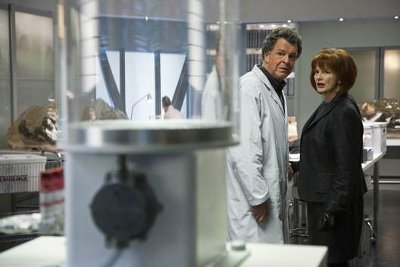
Amber, the glue that binds reality together.
Earth-1 (several decades later than Earth-2) is finally starting to come apart at the seams, with mysterious ghostly goings-on in an apartment building. Who you gonna call?
This episode is debunked at Polite Dissent and Cordial Deconstruction, and you can read more about it at Fox, IMDb and the A.V. Club.
Random thoughts
I’m not sure if the glowing-door-outline counts as a Door of Doom, but it certainly reminded me of Dana’s apartment in Ghostbusters.
Walter requests that Peter grab a “digital spectrometer”, which is kind of a pleonasm because almost all modern spectrometers use digital processing and display. Spectrometers measure electromagnetic radiation, but are generally only useful in controlled settings (such as a laboratory) as they require quite strict sample preparation procedures. By way of counterpoint to all this digital technology, Walter also brings along his ancient Geiger counter (he calls it a radiological survey meter), which I believe is a Victoreen Fallout Detection Meter from the Cold War. This may be the same instrument he uses in Bad Dreams (season 1, episode 17).
As other Futurama fans have pointed out, coin flips in Universe-2 have the opposite outcome.
Ah, quantum entanglement. No, it does not really apply to people (for one thing, there is no information exchange) – but I feel that Walter was just using it as a metaphor for how the two Universes are linked.
If distance makes no difference to the universe-ripping, the FBI could have just forcibly removed Alive from her apartment and convinced her that she wasn’t seeing her husband once outside, without risking two of their least-replaceable agents.
 Leave a Comment » |
Leave a Comment » |  Fringe, science, season 3, television | Tagged: 6B, e14, episode 14, Fox, Fringe, s03, s3, season 3, television, TV |
Fringe, science, season 3, television | Tagged: 6B, e14, episode 14, Fox, Fringe, s03, s3, season 3, television, TV |  Permalink
Permalink
 Posted by John
Posted by John
February 15, 2011
Fringe : Season 3 : Episode 13 : “Immortality”
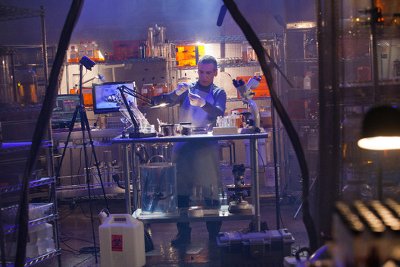
Dr. Silva at work.
Over in Universe-2, it appears that the Fringe team has just as much trouble with rogue scientists as their Universe-1 counterparts. Somebody is experimenting on humans, and since that somebody is not Walternate the government will be breaking down his door in short order. There’s actually some science to talk about this week – mostly historical, but I’ll take it.
This episode is debunked at Polite Dissent and Cordial Deconstruction, and you can read more about it at Fox, IMDb and the A.V. Club.
Random thoughts

Roxarsone, a common additive in chicken feed.
Arsenic trioxide (As2O3), seen in the insect lab, is a highly toxic chemical with few direct uses. It is mostly used as a starting reagent to make other things – including several pesticides and animal feed additives, which the lab may have been testing.
Linnaeus-2 appears to have been just as adept as Linnaeus-1, creating an identical taxonomy. Coleoptera is a taxonomic order containing the beetles, and Archostemata is a small, relatively rare, suborder. Skelter beetles do not exist on Earth-1, as does not the Latin name Mansonium boogliosis.
Earth-2’s scientific history is remarkably similar to Earth-1’s. Jonas Salk developed the first safe polio vaccine, and Crick and Watson proposed the double helix structure for DNA. As a chemist, I cannot let a reference to James Watson arise without mentioning that he used (less charitable people would say “stole”) results obtained by Rosalind Franklin and Raymond Gosling, neither of whom were credited favourably in Waston’s account of the discovery. I found his book The Double Helix to be so unprofessional (filled with distasteful accounts of him avoiding work, playing tennis, chasing women and insulting his colleagues) that I gave away my copy in disgust.
Nitpick: Walternate refers to his lady friend as “Reiko” (which sounded like “Noriko” to me, but I’ll defer to the A. V. Club review), suggesting that she is Japanese. This conflicts with her Chinese accent (which may yet come to be known as the Memoirs of a Geisha effect) – perhaps China invaded and occupied Japan in Earth-2’s WWII?
On Earth-2, industrial freezers are made to lock people in! Fortuitously, Agent Lee finds a container of liquid nitrogen and freezes the door handle to escape – forgetting that using an asphyxiating gas in a closed space is a great way to kill yourself. Perhaps he was desperate, and reasoned that he’d freeze if he didn’t risk it. But if Dr. Silva was working alone and in secret, why did he need a sign on the door to remind himself how to get out?

Metrifonate, scourge of Earth-2 parasites.
Fringe first: a medicine question I actually have some experience in! Metrifonate is an anti-parasitic on Earth-1 too, and used to be used to treat schistosomiasis. The current treatment of choice is Praziquantel, which I had to take the last time I was in Kenya and comes in absolutely enormous pills.
 1 Comment |
1 Comment |  chemistry, Fringe, science, season 3, television | Tagged: "skelter beetle", Archostemata, arsenic, Coleoptera, e13, episode 13, Fox, Fringe, Immortality, James Watson, Metrifonate, Rosalind Franklin, s03, s3, television, TV |
chemistry, Fringe, science, season 3, television | Tagged: "skelter beetle", Archostemata, arsenic, Coleoptera, e13, episode 13, Fox, Fringe, Immortality, James Watson, Metrifonate, Rosalind Franklin, s03, s3, television, TV |  Permalink
Permalink
 Posted by John
Posted by John




 Posted by John
Posted by John 












